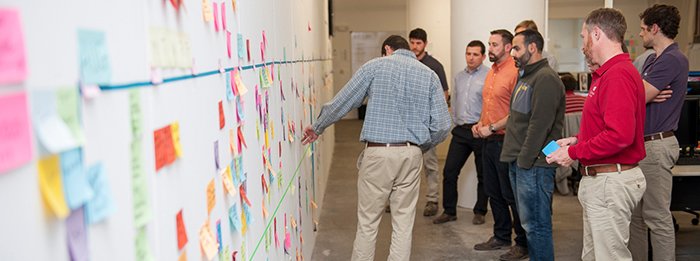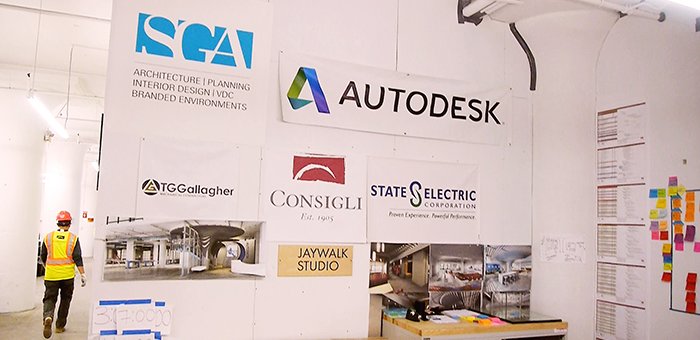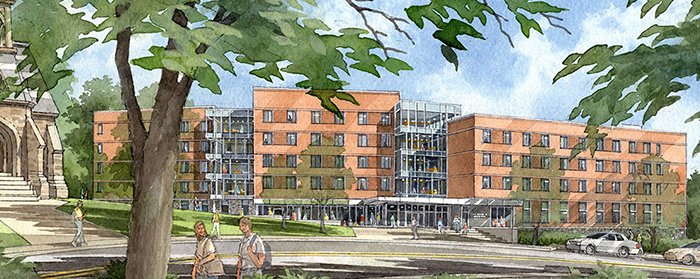
BOSTON, MA – Lean project delivery makes a remarkable impact on construction projects of all shapes and sizes. Today, the time, labor and cost reducing efforts that are the cornerstones of Lean project delivery have been embraced by leading construction companies.
What hasn’t been embraced by all—and is central to Consigli—is tailoring Lean construction management tools and techniques for each project. This customization, guided by Consigli’s Director of Lean Strategy, Cynthia Tsao, makes Consigli’s Lean approaches strongest for clients and project teams.
Tsao, a leader in the transformation and adoption of Lean thinking for the construction industry for almost twenty years, explains the central tenets of Lean construction, “Lean efforts focus on identifying opportunities to reduce inefficient use of resources, and to create more value through our work. During design, Lean efforts work on improving the decision-making process so project buy-out, procurement and job-site work can proceed as planned. During construction, Lean efforts seek to improve both productivity and safety for all trades on the jobsite.”
Autodesk in Boston’s Seaport: Building for Innovation with Integrated Project Delivery and Lean
Building industry software innovator Autodesk has joined Boston’s Seaport innovation community, moving from the ‘burbs of Waltham, Mass. to 70,000-square-feet of customized space in the Seaport’s monumental Innovation and Design Building. These new digs combine an advanced workshop for research and prototyping digital fabrication methods and construction automation for the AEC (architecture, engineering and construction) industry, with collaborative office space. Called “BUILD Space”—for “Building, Innovation, Learning and Design”—these are definitely not run-of-the-mill workspaces, and the construction process has been fittingly innovative, too.
Autodesk’s Vice President Jim Lynch, explains the vision behind BUILD Space, “We want to increase Autodesk’s visibility and connection to the Boston technology culture and engagement with the innovation ecosystem. Another goal is to have the community gain a better appreciation for the impact that Autodesk customers and technology have in this world. We want to expose the community to the things we do around the built environment.”
The Right People in the Room
Consigli’s Project Superintendent, Matt Guimond, talks about the combined impact of Integrated Project Delivery and Lean. “As an Integrated Project Delivery project, we have the great benefit of being a co-located team, all together—Autodesk’s project manager, the project’s architects Spagnolo Gisness & Associates (SGA), engineers, M/E/P subcontractors and our Consigli team—on-site at the Design and Innovation Building. It is great for efficient communication. When you have the right people in the room, things can go very fast.”
“And a co-located team also helps smooth out the “Request for Information” (RFI) process—the clarification of design information—in important ways. We’ve been able to shorten the typical two-week long RFI process to a single day because the architect or engineer you need to get a clarification from is sitting next to you. Also, a co-located team reduces the need to overload the design team with a lot of questions at any one time.”
A 60-Foot Schedule
Lean’s Pull Planning process—planning a project collaboratively as a production system—has been central to the project’s success. The team has used Pull Planning on two levels: for high-level milestone planning, and for detailed plans of what’s needed to get to each milestone, which are developed hand-in-hand with the trade foremen.
Guimond explained, “One of our first Lean steps was developing a Pull Plan with the project management team. Literally 60-feet-long, spread across the wall of the team’s co-location room, each milestone of the project is shown as a colored paper “sticky.” When one project milestone is moved, you automatically see the effect it has on the schedule, project-wide.”
“Using it is invaluable. It quickly brought to light that we needed to track individually—rather than collectively—the 100 pieces of leading-edge technology equipment to be installed. Including everything from robots to 3D printers, they’re all part of the BUILD Space.
Customizing Design with Design-Assist
The innovative and collaborative “Design-Assist” process—which breaks with building industry tradition and pairs design team members with construction trades and vendors—has also been an important part of the project. When Autodesk decided that they wanted their conference rooms to be modular and reconfigurable, the project’s architects, SGA, created a design concept that was then developed by Consigli’s team, with help from specialty interior contractors Creative Office Pavilion (COP), and millwork vendor, DIRTT.
For the full Lean Case Study, click here.
UMass Memorial Health Care’s Revitalization: “Kit of Parts” for Patient-Centered Construction
Lean Focused, Patient Centered
“In planning the Leanest, lowest impact approach for the renovation of UMass Memorial Health Care’s (UMMHC) 250 patient rooms, we customized the Lean material delivery concept of ‘Just-in-Time-Delivery,’ expanding it to ‘Just-in-Time Construction,’ by identifying a way to renovate the patient rooms through a construction ‘kit of parts’ approach,” explains Rick Gala, Project Manager for UMMHC’s Campus Refresh project.
The Project Challenge
The challenge for Consigli? Renovate these 250 patient rooms and the public areas, with as few as four rooms out-of-service at a time, and with as little disruption to each campus’ daily operations as possible.
In developing their Lean approach, the questions for the team became:
- Can we limit what needs to done on-site?
- Can we limit the disruption of delivering materials through the hospital campus?
- Can we reduce the construction packaging brought on-site?
- Can we increase pre-fabrication opportunities through Target Value Design?
A “Kit of Parts” Approach to Patient Room Renovations
Consigli’s “Yes, we can!” answer to all these questions was one inspired by a Lean manufacturing approach, helped by the repetitive nature of the patient room renovations. While the dimensions vary for some of these rooms, the bathroom components, millwork, interior finishes and equipment for them are the same. The team realized that almost all of the materials needed for each room could be prepared for installation at Consigli’s Milford-based Pre-Fab Lab, where the materials are organized by construction sequence, pre-packaged into four “Construction Kit” categories, and delivered “just-in-time” for their installation. Organized into a Bathroom Kit, Finish Kits One and Two, and a Millwork Kit, together these prepared kits account for 80% of the materials needed for each room’s renovation.
The benefits of this kit-of-parts approach:
- Minimizes disruption of deliveries and traffic to the campuses
- Limits material storage and handling on-site
- Ensures materials are ready when each room is scheduled for renovation
- Anticipates and allows for customization
- Reduces construction packaging brought on site
- Simplifies subcontractor scheduling
- Supports safest construction site practices
- Reduces cost
The “Choosing By Advantages” Advantage
“Choosing by Advantages” is another Lean process that’s a perfect fit for the UMMHC project. Through Choosing by Advantages (CBA)— a structured decision-making process— clients review construction material choices through the lens of their advantages from the end-users’ perspectives. This process facilitates decision-making while also helping avoid a later need to replace or rework an aspect of a project when a less thoughtfully chosen component is found to be a problem.
CBA is also another way that Consigli and the project’s architects, S/L/A/M, are keeping the experience of patient and healthcare staff at the center. This comprehensive review considers patient and health care staff ease-of-experience, and the physical impact of construction materials. The client will consider the advantages of which patient room flooring to use? A more expensive choice that’s most comfortable underfoot for staff, or a less expensive option that makes for a louder footfall? What is the best lighting choice from the perspective of the patient lying on a gurney in a hallway, en route to surgery? Which bed-curtain track allows staff to open and close curtains quietly and quickly, supporting patient privacy and calm?
For the full Lean Case Study, click here.
Building Framingham State University’s West Hall: Lateral Thinking for a Fast-Track
With a 27% growth in enrollment over the past five years, it is vital that Framingham State University’s new 317-bed residential building be ready for students in the fall of 2016. To build this suite-style hall, Consigli’s team is using Lean Project Delivery, customized for the fast-track construction of the 97,000-square-foot West Hall. Guiding the project are the team’s series of Pull Plans—the literal step-by-step plans of work phases to be built developed collaboratively with the project’s trade foremen—and the daily “Flow Board” tracking of work planned against work completed or re-planned.
Team Recommendation: Build Horizontally
On a recent January day, the real bustle of work is inside, as Consigli’s team of contractors make their way systematically across each floor, putting in place the layers of construction that make up each of the 100 suites. Across each floor, sandwiches of metal studs, insulation, wall board, taping, wall sanding, painting and room finishes are being built up.
This flow of each piece of work moving smoothly to the next is the heart of Lean Project Delivery. It is the direct result of the FSU team’s Lean Pull Planning.
Assistant Superintendent Duncan Schuster noted the powerful team buy-in Pull Planning creates. “When we do our Pull Planning, each sub speaks to the time needed for their work and their man power and we review to make sure everything planned is feasible. It gets them involved and helps everyone to own the dates for their work. Everyone has a voice.”
This horizontal progression was not the team’s first assumption of the most efficient way to build the interior, but after the team’s half-day Pull Planning session with all the trade foremen responsible for the work to come, the benefits of this approach became clear as they planned the interior construction’s milestones.
“It was our drywall contractor who first saw that this might be a good way to go,” explained Project Manager Jody Staruk. “And all the other foremen agreed it would be a great approach.”
Mini Pull-Plans, Maximum Benefits
The team has collaboratively created Pull Plans for many phases of the work. Beginning with a structural Pull Plan, they moved on to the interior plan for the six floors of suites, as well as creating individual “mini-project” Pull Plans for the building’s public areas, which are being built concurrently. Next up will be the Pull Plan for the building’s exterior.
Like the interior Pull Plan for the suites’ construction, the mini Pull Plans revealed valuable information. Completed for the building’s common spaces—the hall’s living room, meeting room, public restrooms and the Resident Director’s apartment—this collaborative process showed that the public areas include almost exactly the same construction tasks the suites require, so the team can continue applying their streamlined approach.
For the full Lean Case Study, click here.



